RVing has been an activity that families have loved doing together for years. Not only does it increase family bonds, but it also creates long-lasting memories that you can share with your kids and grandkids one day. “Nature delivers a full-on sensory experience (REI)”. Camping totally immerses you in the outdoors with all the sites, sounds, and smells that go along with it. It has the potential to be a core memory for your family. It’s no wonder that many people like to start RVing with their little ones early on. Like everything else, traveling in an RV with a baby requires patience and plenty of planning.
These 7 hacks will help you have peace of mind about bringing your bundle of joy out on the road.
Key considerations before you hit the road.
First things first, car seat placement in an RV can be very difficult. Many RVs have plenty of space for a family, but this does mean they provide adequate and safe seats for your infants and toddlers. Safety experts generally discourage actually transporting children in RVs since it is essentially impossible to do so with optimal safety. Finding an RV with proper backseat options for your car seat or booster seat is easier said than done. Proper car seat installation requires a forward-facing seat and seat belts (shoulder and lap restraints) that are bolted directly to the frame of the RV. Parents should know you should never install a car seat in a side or rear-facing vehicle seat.
The RVing experience is still possible by traveling with a towable RV (camper, travel trailer, or fifth wheel). Traveling in this manner will allow your children to ride properly restrained in the towing vehicle. Another option is to have another adult traveling with you drive a separate car in order to accommodate the littlest travelers.
If traveling in an RV is a must, carefully review the RV and car seat manuals to ensure your children are properly buckled in a car seat every time you are driving. With this additional information, you will feel empowered to make the best possible decision for your family.
Practice, practice, practice.
“If it’s your first time out, start small, stick close to home, and choose more developed campgrounds with buckets of amenities. Work your way up to more remote or adventurous locations or longer trips”(REI). Pitch a tent in your backyard or open the RV/trailer up in the driveway for a night or two. Practice will allow your children to start getting comfortable in a different environment. It will reduce some of the fear of sleeping in a new place. It will also help you begin to figure out what works and what doesn’t work before you are on the road. Is there something you didn’t put in the trailer that you absolutely cannot live without? Do you have too much stuff? Doing a trial night or two will help determine if you and the family need to make some adjustments.
Get the littlest travelers involved.
Giving your children age-appropriate tasks like packing their clothes, toys, and food may help relieve some of their anxiety around traveling. This is definitely age dependent. With guidance, some older children can pack the extras that they may need to keep cool or to stay warm. They can also help gather toys for outdoor activities. As the parent/guardian, you may need to go through everything and pare down to the essentials for the kids, but this is another great way to get them involved and reduce anxiety.
Another great time to get your children involved is when you’re putting together all the food you plan to bring with you. Allowing them to pick some of their favorite foods, within reason, will help ease their trepidation. It is also a great idea to hype up some of the food that you’ll be able to make over the campfire. Think hot dogs, baked potatoes, canned beans, etc. Make sure to remember all the fixings to make s’mores. They are a camping staple!
Pack like a pro.
If you think camping is going to be something you regularly add to your family’s schedule, or you travel a good bit in general, consider investing in packing cubes/shelves. Packing shelves will allow you to keep everyone’s clothes organized and easily hang everything in a closet or in a vertical space. If closet space is limited, think about using packing cubes instead. They will also keep you organized by groupings like items or one person’s clothes all together.
A long day of travel can have all family members on edge. And then the campsite still needs to be set up. #Facepalm. For everyone’s well-being, consider putting together small feeding kits or play kits for your children for when you arrive—think of some special or favorite snack foods. Put some coloring books and crayons aside; or put together small play packs of kinetic sand, play-doh, and the like to stave off boredom and meltdowns while the campsite is being set up.
1. Bring baby gates to make RVing and camping safer.
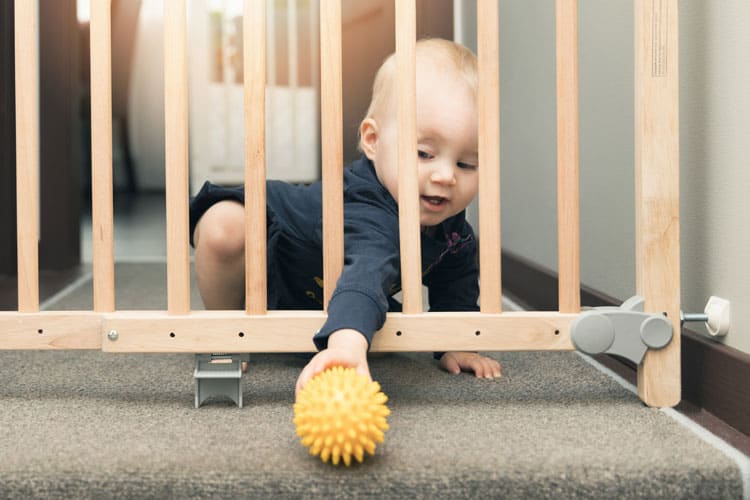
There are a lot of spaces that a little one shouldn’t be getting into when in an RV. Luckily, most RVs are pretty well baby proofed as is. Drawers and cabinets typically come with security latches of some sort. These help to prevent curious little hands from getting into things they shouldn’t. There are other areas that could pose danger as well. Use a baby gate to block off the stairs and areas like the kitchen where babies can get into trouble if unsupervised. Dangerous items that are used less frequently, such as cleaning supplies, can be stored in one of the many ‘hidden’ compartments. Think under the bed in the master bedroom, or under the cushions of the dinette; both locations typically have large storage compartments.
A large enclosed playpen (with some sort of floor) would be a great thing to have at the campsite, assuming storage space allows for it while traveling. If your children are very young, this will be a great place to keep them safe and have them contained while you’re setting up or taking down the campsite. It’s also going to be a great way to keep them near a campfire but also far enough away to be safe. If the playpen has a soft floor, you won’t have to worry about the grass being uneven or small sticks hurting their feet or legs as they move around. Some even have shade covers to help keep little ones cool during the summer months. It would be a great addition to a day at the beach, as well!
2. Tablets and electronic devices can be a lifesaver at times.
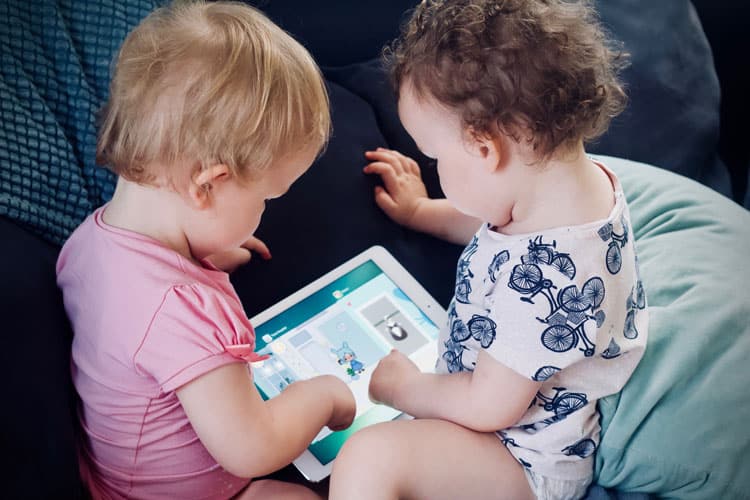
Okay, okay, we don’t want our kids getting addicted to technology at such a young age but there are times where you are driving on the road for hours at a time and children get restless. Whether they’re at the stage of watching videos with lullabies or they’re already hooked on YouTube, having a tablet can be a lifesaver. But sitting there and holding it for them can be uncomfortable. Having a tablet mount that hooks up to the back of a seat help keep them occupied.
Hold out as long as you can in giving the littlest a tablet during your travels. There’s no going back, the kids will eventually grow bored with the tablet as well. Grab Melissa & Doug’s On-the-GO activity books or Water WOW books and offer them one at a time to your children. Susie Allison, over at Busy Toddler, has some awesome activity suggestions on her blog for staying sane while traveling with toddlers and young children (just search ‘travel’ on her blog). As mentioned earlier, this is another great time for little play kits to keep the little ones entertained. Think about items/toys that you maybe wouldn’t traditionally have them play with at home or create some kits with new-to-them items/toys. Novelty seems to increase the overall total interest time for little ones.
This way tablets are saved for the worst-case scenario or the most epic of meltdowns.
3. Use noise machines in campers to keep baby sleeping soundly.

If your baby is a light sleeper, a noise machine will be life-changing to have on your RV trips. The walls of an RV are typically paper thin and if your neighbor closes their car door, you’ll hear it. If the wind is blowing strong at night, you’ll hear it. This easy-to-pack item is especially useful if your baby is still napping during the day. You won’t have to worry when the neighbor’s dog starts barking!
4. Add a collapsible high chair to your list of must-have baby gear for camping.
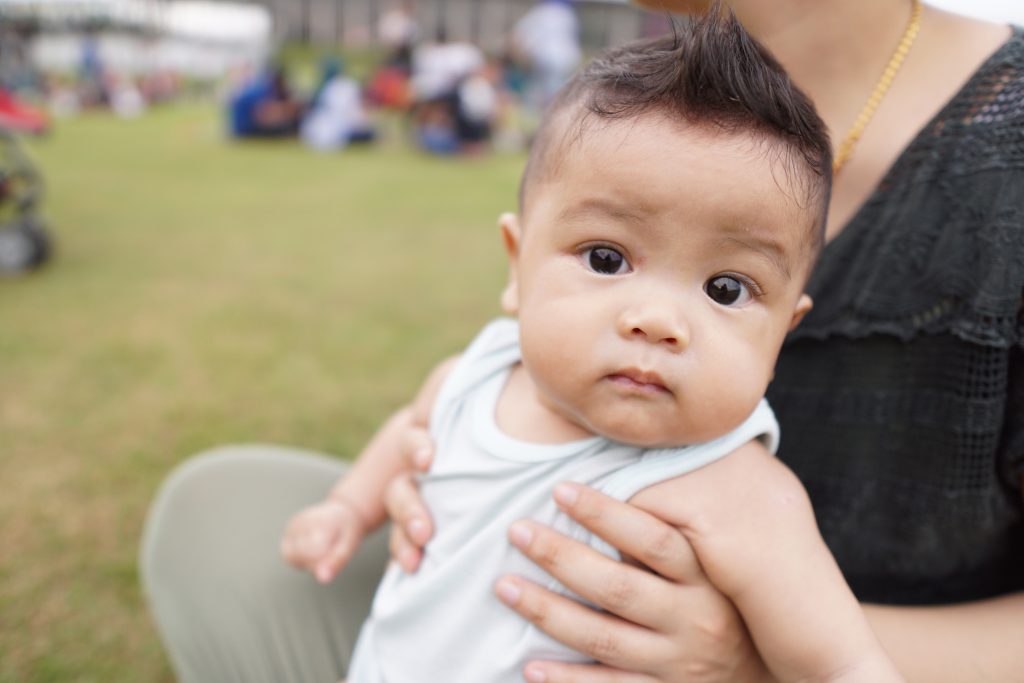
Bringing along a small, collapsible high chair or booster seat will allow you to keep meal times as easy as possible and feed your littlest ones with relative ease. A collapsible high chair, like this Hiccapop Booster Chair, will take up the least amount of space and allow you to bring it with you to the park/playground, the beach, and any place that you could be going with your child. Since we all know the littlest ones are also the most difficult to wrangle, a collapsible high chair or booster seat will provide another way to ‘contain’ your little one for a few minutes.
Related Articles:
- Family Road Trip Survival Guide
- 13 Creative Ways to Preserve Family Travel Memories
- How to Get Started Renting Baby Gear
5. Toy haulers are great for all the baby gear you may need.
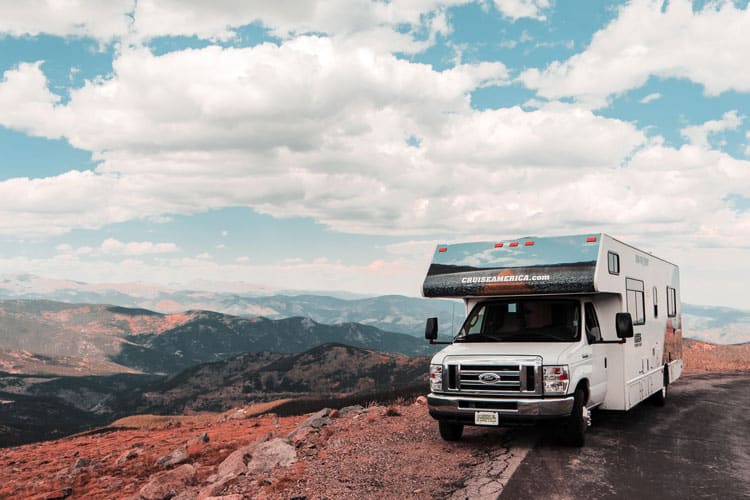
Whether you’re looking to rent an RV or buy one, look into getting a toy hauler. Typically used to house toys like ATVs, these RVs have extra space that you can use for many purposes. Set it up as a nursery, or office space or use it for extra storage. You can easily fit a full-sized crib on one side, and store baby’s clothes and toys on the other.
6. Always bring a backpack carrier on camping trips.
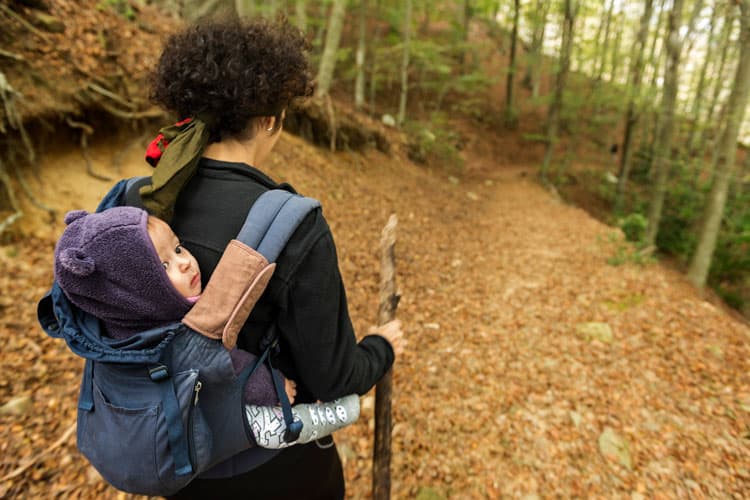
So we’ve covered a few things inside of the RV but going RVing is so much more than that. It’s about disconnecting from distractions to reconnect as a family. It is all about visiting new destinations and going outside to explore nature and all that it has to offer. Having a carrier that will allow you to take baby with you without breaking your back or having to push a stroller over rough terrain is key.
A backpack carrier will allow you to see the world without stopping every few minutes. Most carriers come with adjustable settings to fit your baby’s size and age. Some of the backpack carriers designed for hiking are extremely comfortable and make it easy to carry baby hands-free. This brings so much more freedom to the trip. Baby is at everyone else’s level and able to see and participate from the security of the carrier.
7. Be flexible and expect the unexpected.
Families new to camping will definitely experience a learning curve, as to be expected. The goal is to ease the adjustments and limit hiccups as best as possible, but the weather forecast is not always accurate. Do your best to make sure that your days are flexible and that there is some downtime for everyone.
Random summer rainstorms are going to happen. Kids are going to get dirty and muddy. Oh so muddy. Do your best to have patience in these situations and make sure you can pivot.
Finally, and opposite to the ‘be flexible’ sentiment, do your best to keep your children in a loose routine. Make sure the cadence of meal times and sleep times are close to the routines at home. Bring their favorite books and make sure to pack their favorite lovey or two so that they have some of the comforts and familiarities of home.
Summary of RVing with babies.
With a little preparation and patience, traveling with baby by RV can be a piece of cake. Make it easier on yourself by packing the equipment you need. Many baby items can be rented so you don’t have to buy or pack them for the brief duration of your trip. The flexibility of an RV allows you to create the perfect home-like setting so your baby’s first RV trip is stressful-free. We hope you put these hacks to work to help make your vacation more enjoyable. Soon you’ll be making RV trips with the family a regular thing!
If RVing is on your family travel bucket list, check out the RV rentals at Outdoorsy.com. You’ll find the perfect RV solution for anywhere you want to go…even Hawaii! Everything is super simple, easy, and fully insured.
**This blog was written by our friends over at Outdoorsy. Hope you enjoyed it!
Jennifer leads the marketing efforts at BabyQuip and is constantly trying to reinvent awesomeness through written copy, visual appeal, creative content & SEO. Jennifer is a mom of two boys and knows first hand the struggles of traveling with babies, toddlers and kids. When Jennifer’s head isn’t swimming with new marketing ideas you’ll find her tending to her backyard chickens and practicing meditation.


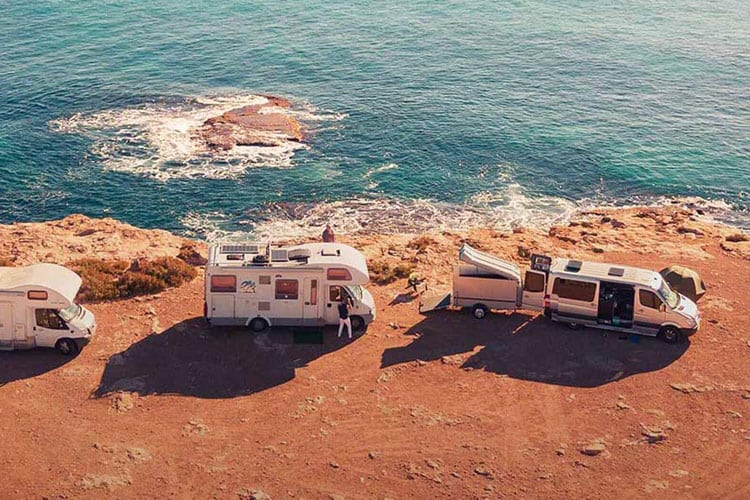
Cool. Your blog looks great, and I’m glad i’ve found something here worth adding to my favorites.
With all the doggone snow we have gotten lately I am stuck indoors, fortunately there is the internet, thanks for giving me something to do.
Pack enough food. Nothing worse than running out of food and having to make a run when you don’t want to!
Lots of good tips here–thanks! I didn’t think of bringing a sound machine, but that’s a great tip. And I learned what a toy hauler is!